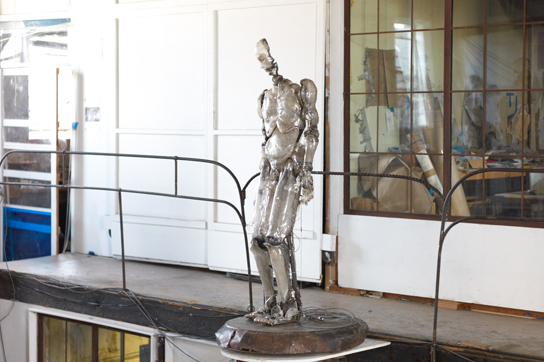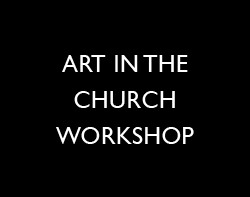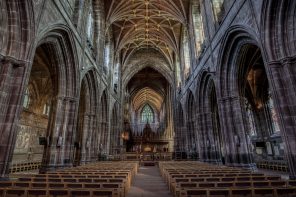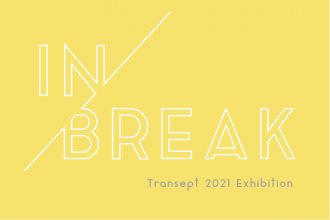“…some to church repair, / Not for the doctrine, but the music there.”
– Alexander Pope [1]

Photo: Robert Wright; Courtesy: Chico MacMurtrie
On most Sundays the Norwegian Seamen’s Church situated in the heart of Brooklyn’s Red Hook district remains shuttered and abandoned, its congregation a mere memory alongside the spires and stained-glass that disappeared after its closing in 1983. All that changed this past September when artist Chico MacMurtrie re-opened the church’s doors for three Sunday services, signaling a revival of sorts in the former Dutch port town. Only, these services were hosted by a distinctly chimerical clergy: robots.
MacMurtrie’s “Robotic Church” is a culmination of the artist’s thirty-year career producing robotic installations that explore the tension between art and artifice, man and machine, and now, worship and widgets. The month-long exhibit featured thirty-five computer-controlled robotic sculptures whose size ranged from twelve-inches to fifteen feet. Upon entering the church one is faced with the familiar alongside the absurd: two rows of wooden pews are divided by a hunched robot attempting to climb a rope that terminates within the limbs of a tree suspended from the ceiling. The church’s white walls evoke an ecclesiastical calm that is echoed by the saint-like postures of robots encircling the the room. “We could sort of conceptually deem them saints,” MacMurtrie mused in a recent interview [2]. One such “saint”, String Body, offers praise by plucking a ribcage constructed of harp strings. Another, Queeko, bangs upon a drum in a mechanical rhythm that is answered by a medley of percussive beats, clangs, and scrapes made by the other machines. Presiding over this motley crew is the twitching limbs of Translucent Body, a gelatinous skeleton suspended at the forefront of the church.

Photo: Douglas Adesko
Such “masses,” as MacMurtrie has come to call his exhibit, seem a frightful evocation of the nature of worship. Indeed, there is a resounding cacophony created by these devices that one perhaps seeks to silence. But if the “Robotic Church” seems a crude affront to the very embodied experience of divine praise as well as indifferent to the Incarnation, its naked mechanicalness also opens us up to the creatureliness of our own existence. This at least is MacMurtrie’s intent: “It’s a parallel between what we’re very familiar with and what we’re getting far away from. We’re getting further and further away from human contact and we’re more interested in our contact with machines” [3]. By conducting an automated orchestra of machines in the postures of praise, MacMurtrie awakens the religious observer to those components of the Church that may never be manufactured: true community, offering, and self-giving amongst them. MacMurtrie accomplishes this through an ingenious blend of humor and fear: “Through humor and through fear I can hit an audience in the nerves and open up a lot for them in terms of their experience” [4].
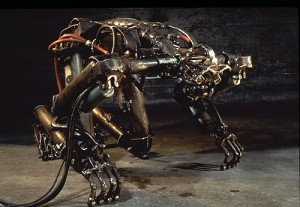
One of the most arresting congregants of the “Robotic Church” is Tumbling Man. Syncing the movements of his limbs via computer to the movements of his observers, Tumbling Man is given life through the activity of others. When deprived of this otherness, Tumbling Man is left to perpetually fall until an observer enters again to teach him the mobility to upright himself.
Such a pitiful machine seems the perfect reminder of the purpose of the human Church.
—
Denny Kinlaw is currently studying for his PhD in the Institute of Theology, Imagination and the Arts, St Mary’s College, University of St Andrews. His interests include American Literature and the intersection of literary theory and theology in the work of David Foster Wallace.
—
[1] Pope, Alexander. An Essay on Criticism, Selected Works, ed. Louis Kronenberger (New York: Random House, The Modern Library, 1951), 41. [2] Tan, Dion. “Chico MacMurtrie Powers a ‘Robotic Church,’ Blouin ArtInfo. http://www.blouinartinfo.com/news/story/973495/video-chico-macmurtrie-powers-a-robotic-church [3] Ibid. [4] Moore, Madison Alexander. “Chico MacMurtrie’s Robot Orchestra Lands in Red Hook,” The Creator’s Project. http://thecreatorsproject.vice.com/blog/chico-macmurtries-robot-orchestra

